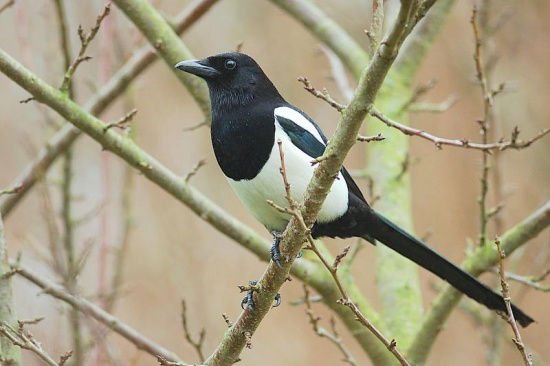Nutcracker (talk | contribs) (more details) |
(Imp sizes. Picture of juveniles. References updated) |
||
| Line 1: | Line 1: | ||
| + | '''Alternative Name: Common Magpie; Pied Magpie''' | ||
[[Image:Common_Magpie.jpg|thumb|550px|right|Photo by {{user|henkdikkers|henkdikkers}}<br />Nuis, [[The Netherlands]], January 2007]] | [[Image:Common_Magpie.jpg|thumb|550px|right|Photo by {{user|henkdikkers|henkdikkers}}<br />Nuis, [[The Netherlands]], January 2007]] | ||
| − | + | ||
;[[: Category:Pica|Pica]] pica | ;[[: Category:Pica|Pica]] pica | ||
'''Includes: Arabian Magpie; Oriental Magpie; Black-rumped Magpie; Kamchatka Magpie; Maghreb Magpie''' | '''Includes: Arabian Magpie; Oriental Magpie; Black-rumped Magpie; Kamchatka Magpie; Maghreb Magpie''' | ||
==Identification== | ==Identification== | ||
[[Image:Magpie IMG 3684.jpg|thumb|350px|right|Photo by {{user|Florian+Andronache|Florian Andronache}}<!--aka Teodor--><br />Romania, May 2008]] | [[Image:Magpie IMG 3684.jpg|thumb|350px|right|Photo by {{user|Florian+Andronache|Florian Andronache}}<!--aka Teodor--><br />Romania, May 2008]] | ||
| − | Length | + | Length 46–50 cm (18-19¾ in); weight 187-268 g (male), 161-240 g (female)<br /> |
* Black head, neck, breast and back | * Black head, neck, breast and back | ||
* Prominent white side patches and belly | * Prominent white side patches and belly | ||
| Line 51: | Line 52: | ||
Several of the subspecies are likely to be split as distinct species in the future, with ''P. p. serica'', ''P. p. mauretanica'', and ''P. p. asirensis'' the strongest contenders<sup>[[#References|[2]]]</sup>. ''P. p. asirensis'' is already treated as a separate species by some authors<sup>[[#References|[3]]]</sup>. See also [http://www.birdforum.net/showthread.php?t=69349&highlight=magpie this forum thread] discussing possible splits. | Several of the subspecies are likely to be split as distinct species in the future, with ''P. p. serica'', ''P. p. mauretanica'', and ''P. p. asirensis'' the strongest contenders<sup>[[#References|[2]]]</sup>. ''P. p. asirensis'' is already treated as a separate species by some authors<sup>[[#References|[3]]]</sup>. See also [http://www.birdforum.net/showthread.php?t=69349&highlight=magpie this forum thread] discussing possible splits. | ||
| + | [[Image:IMG 1548a.jpg|thumb|350px|right|Juvenile<br />Photo by {{user|Mohamad+Kamrani|Mohamad Kamrani}}<br />Nahavand, [[Iran]]]] | ||
==Habitat== | ==Habitat== | ||
Farmland and open country. Also town gardens and parks. | Farmland and open country. Also town gardens and parks. | ||
| Line 66: | Line 68: | ||
''[[Media:Pica pica (song).mp3|Listen in an external program]]'' | ''[[Media:Pica pica (song).mp3|Listen in an external program]]'' | ||
==References== | ==References== | ||
| − | #{{Ref- | + | #{{Ref-Clements6thAug15}}#{{Ref-GillDonsker14V4.4}}#{{Ref-HBWVol14}}#Birdwatchers Pocket Guide ISBN 1-85732-804-3 |
#Collins Pocket Guide to British Birds 1966 | #Collins Pocket Guide to British Birds 1966 | ||
#Collins Field Guid 5th Edition | #Collins Field Guid 5th Edition | ||
Revision as of 00:37, 16 February 2016
Alternative Name: Common Magpie; Pied Magpie
- Pica pica
Includes: Arabian Magpie; Oriental Magpie; Black-rumped Magpie; Kamchatka Magpie; Maghreb Magpie
Identification
Length 46–50 cm (18-19¾ in); weight 187-268 g (male), 161-240 g (female)
- Black head, neck, breast and back
- Prominent white side patches and belly
- Wings and tail, whilst looking black in certain lights, are actually bluey-green and purple
- Very long tail, diamond-shaped when spread out
Subspecies Variations
- P. p. bottanensis has a black rump, a short tail, a stout bill and only little gloss in plumage
- P. p. serica is dark and small and has a short tail
- P. p. mauritanica has a patch of blue bare skin behind the eye
- P. p. asirensis is darker, has a black rump, less white in plumage and a short tail
Sexes are similar. Juveniles are duller than adults.
Distribution
Found in most of Europe, the Middle East, northern Africa (Morocco, Algeria, Tunisia), Saudi Arabia (Asir massif), central Asia to China, Korea, Japan and east Siberia.
Widespread and common in most of its range.
Taxonomy
This species was formerly considered conspecific with Black-billed Magpie P. hudsonia.
Subspecies
About 12 subspecies are recognised[1]:
- P. p. pica:
- British Isles, southern Scandinavia, central and eastern Europe to Asia Minor
- P. p. fennorum:
- Northern Scandinavia and western Russia
- P. p. galliae:
- P. p. melanotos:
- P. p. mauretanica (Maghreb Magpie):
- North-eastern Mauritania to Morocco, Algeria and Tunisia
- P. p. asirensis (Arabian Magpie):
- Assir Mountains (south-western Arabia)
- P. p. bactriana:
- P. p. hemileucoptera:
- P. p. leucoptera:
- Southern Transbaicalia to eastern Mongolia and Altai Mountains
- P. p. camtschatica (Kamchatka Magpie):
- Northern shores of Sea of Okhotsk to Kamchatka Peninsula
- P. p. bottanensis (Black-rumped or Tibetian Magpie):
- P. p. serica (alternative spelling sericea (Oriental Magpie):
Several of the subspecies are likely to be split as distinct species in the future, with P. p. serica, P. p. mauretanica, and P. p. asirensis the strongest contenders[2]. P. p. asirensis is already treated as a separate species by some authors[3]. See also this forum thread discussing possible splits.
Habitat
Farmland and open country. Also town gardens and parks.
Behaviour
Walks and will hop sideways.
Flight
Quick, with deep, fast, even wing beats. Short glides.
Diet
Omnivorous. Feeds mainly on invertebrates, small mammals, lizards, frogs, bird eggs, nestlings and carrion.
Breeding
Builds a domed nest in tall trees, or hedgerows which often contains shiny objects
Vocalisation
Harsh "chack, chack, chack".
<flashmp3>Pica pica (song).mp3</flashmp3>
Listen in an external program
References
- Clements, J. F., T. S. Schulenberg, M. J. Iliff, D. Roberson, T. A. Fredericks, B. L. Sullivan, and C. L. Wood. 2015. The eBird/Clements checklist of birds of the world: v2015, with updates to August 2015. Downloaded from http://www.birds.cornell.edu/clementschecklist/download/
- Gill, F and D Donsker (Eds). 2014. IOC World Bird Names (version 4.4). Available at http://www.worldbirdnames.org/.
- Del Hoyo, J, A Elliott, and D Christie, eds. 2009. Handbook of the Birds of the World. Volume 14: Bush-shrikes to Old World Sparrows. Barcelona: Lynx Edicions. ISBN 978-8496553507
- Birdwatchers Pocket Guide ISBN 1-85732-804-3
- Collins Pocket Guide to British Birds 1966
- Collins Field Guid 5th Edition
Recommended Citation
- BirdForum Opus contributors. (2024) Eurasian Magpie. In: BirdForum, the forum for wild birds and birding. Retrieved 4 May 2024 from https://www.birdforum.net/opus/Eurasian_Magpie
External Links








